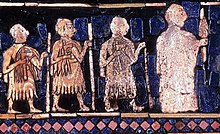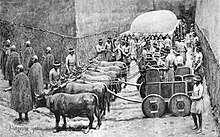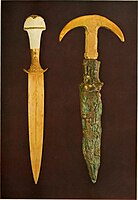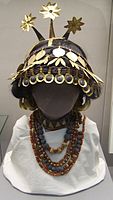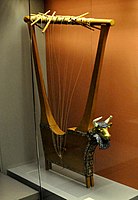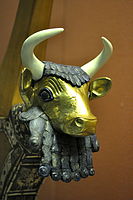
Sumer is the earliest known civilization in the historical region of southern Mesopotamia, emerging during the Chalcolithic and early Bronze Ages between the sixth and fifth millennium BC. It is one of the cradles of civilization in the world, along with ancient Egypt, Elam, the Caral-Supe civilization, Mesoamerica, the Indus Valley civilisation, and ancient China. Living along the valleys of the Tigris and Euphrates rivers, Sumerian farmers grew an abundance of grain and other crops, the surplus from which enabled them to form urban settlements. Proto-writing dates back before 3000 BC. The earliest texts come from the cities of Uruk and Jemdet Nasr, and date to between c. 3500 and c. 3000 BC.
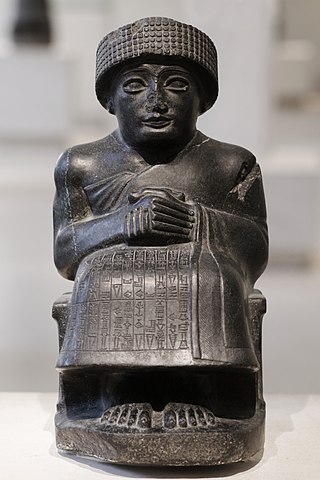
The history of Sumer spans the 5th to 3rd millennia BCE in southern Mesopotamia, and is taken to include the prehistoric Ubaid and Uruk periods. Sumer was the region's earliest known civilization and ended with the downfall of the Third Dynasty of Ur around 2004 BCE. It was followed by a transitional period of Amorite states before the rise of Babylonia in the 18th century BCE.

Puabi, also called Shubad or Shudi-Ad due to a misinterpretation by Sir Charles Leonard Woolley, was an important woman in the Sumerian city of Ur, during the First Dynasty of Ur. Commonly labeled as a "queen", her status is somewhat in dispute, although several cylinder seals in her tomb, labeled grave PG 800 at the Royal Cemetery at Ur, identify her by the title "nin" or "eresh", a Sumerian word denoting a queen or a priestess. Puabi's seal does not place her in relation to any king or husband, possibly indicating that she ruled in her own right. It has been suggested that she was the second wife of king Meskalamdug. The fact that Puabi, herself a Semitic Akkadian, was an important figure among Sumerians, indicates a high degree of cultural exchange and influence among the ancient Sumerians and their Semitic neighbors. Although little is known about Puabi's life, the discovery of Puabi's tomb and its death pit reveals important information as well as raises questions about Mesopotamian society and culture.

Mesannepada, Mesh-Ane-pada or Mes-Anne-pada was the first king listed for the First Dynasty of Ur on the Sumerian king list. He is listed to have ruled for 80 years, having overthrown Lugal-kitun of Uruk: "Then Unug (Uruk) was defeated and the kingship was taken to Urim (Ur)". In one of his seals, found in the Royal Cemetery at Ur, he is also described as king of Kish.

Elulu is listed as the third king of the First Dynasty of Ur on the Sumerian king list, which states he reigned for 25 years.

Meluḫḫa or Melukhkha is the Sumerian name of a prominent trading partner of Sumer during the Middle Bronze Age. Its identification remains an open question, but most scholars associate it with the Indus Valley civilisation.

Meskalamdug was an early Sumerian ruler of the First Dynasty of Ur in the 26th century BCE. He does not appear in the Sumerian King List, but is known from a royal cylinder seal found in the Royal Cemetery at Ur, a royal bead inscription found in Mari, both mentioning him as King, and possibly his tomb, grave PG 755 at the Royal Cemetery at Ur.

The Early Dynastic period is an archaeological culture in Mesopotamia that is generally dated to c. 2900–2350 BC and was preceded by the Uruk and Jemdet Nasr periods. It saw the development of writing and the formation of the first cities and states. The ED itself was characterized by the existence of multiple city-states: small states with a relatively simple structure that developed and solidified over time. This development ultimately led to the unification of much of Mesopotamia under the rule of Sargon, the first monarch of the Akkadian Empire. Despite this political fragmentation, the ED city-states shared a relatively homogeneous material culture. Sumerian cities such as Uruk, Ur, Lagash, Umma, and Nippur located in Lower Mesopotamia were very powerful and influential. To the north and west stretched states centered on cities such as Kish, Mari, Nagar, and Ebla.
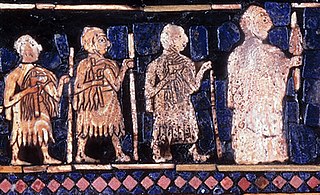
Balulu was the final king of the First Dynasty of Ur, according to the Sumerian King List, which states he ruled for 36 years:
"... Mesh-ki-ang-Nanna, son of Mesannepada, was king, 36 years he ruled; Elulu, 25 years he ruled; Balulu, 36 years he ruled; 4 kings, the years: 171(?) they ruled. Ur with weapons was struck down; the kingship to Awan was carried off.

The Royal Cemetery at Ur is an archaeological site in modern-day Dhi Qar Governorate in southern Iraq. The initial excavations at Ur took place between 1922 and 1934 under the direction of Leonard Woolley in association with the British Museum and the University of Pennsylvania Museum of Archaeology and Anthropology in Philadelphia, Pennsylvania.
Ansud, was an early king (Lugal) of the second Mariote kingdom who reigned c. 2423-2416 BC. Ansud is known for warring against the Eblaites from a letter written by the later Mariote king Enna-Dagan.

Meskiagnun, also Mesh-ki-ang-Nanna, was the fourth lugal or king of the First Dynasty of Ur, according to the Sumerian King List, which states he ruled for 36 years.

Akalamdug was an early ruler of the First Dynasty of Ur in the 26th century BCE. He does not appear in the Sumerian King List, but is known from his tomb and an inscription at the Royal Cemetery at Ur. He may have been the father of Meskalamdug, as suggested by the similarity of their names and the chronological proximity of their graves. Alternatively, he may have been the son of Meskalamdug, and therefore brother of the great ruler Mesannepada.

Ur-Pabilsag was an early ruler of the First Dynasty of Ur in the 26th century BCE. He does not appear in the Sumerian King List, but is known from an inscription fragment found in Ur, bearing the title "Ur-Pabilsag, king of Ur". It has been suggested that his tomb is at the Royal Cemetery at Ur. He may have died around 2550 BCE.

A-Imdugud, was an early ruler of the First Dynasty of Ur in the 27th century BCE. He does not appear in the Sumerian King List, but is known from an inscribed seal found in tomb PG 1236 in the Royal Cemetery at Ur, which is the largest and probably the earliest tomb structure at the cemetery.

A'annepada was a king of the First Dynasty of Ur, circa 2600 BCE. He was a son of Mesannepada. It is thought that his tomb may be tomb PG 580 in the Royal Cemetery at Ur.

Lugal-kinishe-dudu also Lugal-kiginne-dudu , was a King and (ensi) of Uruk and Ur who lived towards the end of the 25th century BCE. The Sumerian King List mentions Lugal-kinishe-dudu as the second king of the dynasty after En-cakanca-ana, attributing to him a fanciful reign of 120 years.
Ur-nigin, also Ur-nigina or Ur-nigar was a Governor (ensi) of Uruk who lived in 22nd century BCE.
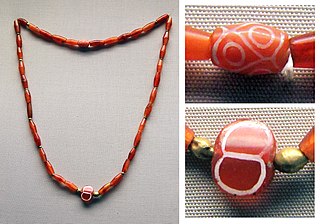
Etched carnelian beads, or sometimes bleached carnelian beads, are a type of ancient decorative beads made from carnelian with an etched design in white, which were probably manufactured by the Indus Valley civilization during the 3rd millennium BCE. They were made according to a technique of alkaline-etching developed by the Harappans, and vast quantities of these beads were found in the archaeological sites of the Indus Valley civilization. They are considered as an important marker of ancient trade between the Indus Valley, Mesopotamia and even Ancient Egypt, as these precious and unique manufactured items circulated in great numbers between these geographical areas during the 3rd millennium BCE, and have been found in numerous tomb deposits.
Ur-gigir was the son of Ur-nigin and a Governor (ensi) of Uruk who lived in 22nd century BCE.







